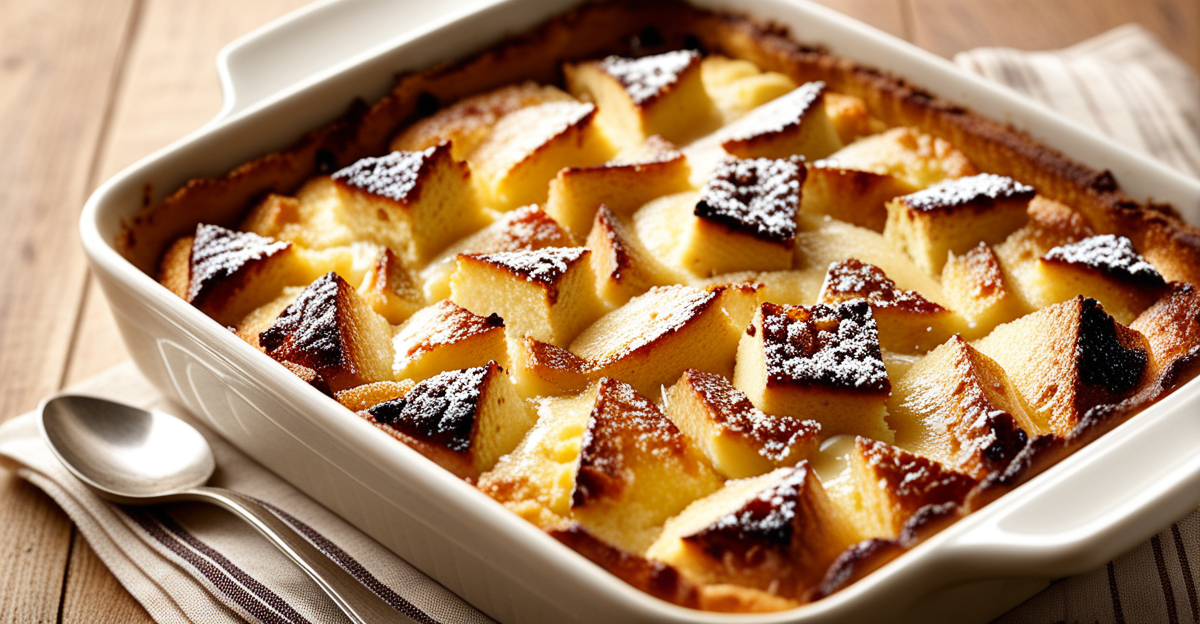Essential Steps for Perfect Bread and Butter Pudding Texture
Achieving the perfect pudding texture starts with selecting the right bread. Preferably, choose bread that balances structure and softness, such as slightly stale white loaf. It holds custard well without falling apart, which is crucial for maintaining the pudding’s form while allowing for a tender bite.
The custard preparation is equally important. Aim for an optimal egg-to-milk ratio—commonly two eggs per 300ml of milk—to create a smooth, silky custard that sets properly but remains moist. This balance ensures the custard provides richness without curdling or becoming rubbery.
Also to read : What Historical Influences Shaped Traditional UK Dishes?
Layering and soaking techniques directly impact bread and butter pudding texture. Dip each bread slice briefly in custard before layering to ensure even absorption; prolonged soaking risks sogginess, while insufficient soaking leads to dryness. Building layers with small intervals of custard pouring between enables consistent soak throughout and avoids a dense mass.
Following this step-by-step pudding process ensures the final dish is both fluffy and creamy, with a delicate crust on top contrasting the soft interior—a hallmark of perfect bread and butter pudding texture.
Also to read : How Can You Recreate Traditional UK Dishes with Modern Twists?
Essential Steps for Perfect Bread and Butter Pudding Texture
To achieve the perfect pudding texture, start with selecting the right bread. Opt for slightly stale or day-old bread, such as white loaf, which offers a sturdy structure while allowing softness after soaking. Fresh bread tends to disintegrate, causing a soggy texture. Butter each slice generously; this creates a protective layer that enhances richness and prevents excessive custard absorption in one spot.
Next, prepare the custard with the optimal egg-to-milk ratio. A common balance is two large eggs to about 300ml of milk or cream. This ratio ensures the custard sets properly without becoming rubbery or too loose, which directly affects the bread and butter pudding texture.
Layering and soaking deserve attention. Arrange the buttered bread slices evenly, ensuring gaps to allow custard flow. Pour the custard slowly for even absorption. Let the pudding rest at room temperature for 20 to 30 minutes before baking. This soaking step is essential; it allows the custard to permeate the bread gently, preventing dry patches while avoiding soggy heaviness. Together, these step-by-step pudding techniques produce a balanced, delightful texture.
Expert Tips to Enhance Creaminess and Structure
Achieving luscious creaminess while maintaining pudding structure
Balancing cream and milk is key to elevating bread and butter pudding creaminess without compromising its structure. For a richer custard, substitute part of the milk with heavy cream—ideally, use a ratio of 200ml milk to 100ml cream. This combination enhances mouthfeel, creating a creamy pudding that feels indulgent but still sets well.
Achieving a consistent soak requires precision. Briefly dipping bread slices ensures even custard absorption and prevents sogginess, which can undermine pudding structure. Pouring a small amount of custard between layers further promotes uniform moisture. These creamy pudding tips prevent the dreaded soggy bottom while maintaining tenderness throughout.
Time and temperature control during baking significantly influence texture. Baking at a moderate 160°C (320°F) allows the custard to set gently, preserving creaminess and preventing curdling. Baking for 35-40 minutes often yields ideal results; underbaking results in a runny pudding, while overbaking dries it out. Using a shallow dish also assists heat distribution, contributing to a consistently smooth texture with distinct layers that hold their shape.
Expert Tips to Enhance Creaminess and Structure
Achieving bread and butter pudding creaminess depends largely on balancing cream and milk. Using a 50-50 mix of whole milk and cream enriches the custard, lending a luscious texture that enhances the perfect pudding texture without overwhelming richness. Adjusting this ratio slightly allows control over softness and mouthfeel.
Consistent soaking is crucial for pudding structure. After layering buttered slices and pouring custard, let the pudding rest at room temperature for 20 to 30 minutes. This encourages an even custard distribution without sogginess. To prevent a soggy pudding, avoid over-soaking bread and ensure each layer receives a measured custard amount. This step-by-step pudding approach maintains structural integrity while promoting creaminess.
Time and temperature control during baking are also essential. Baking at a moderate 160–170°C (320–340°F) gently sets the custard, preserving softness. High heat risks curdling or drying, which impacts both bread and butter pudding texture and creaminess. Checking the pudding midway encourages even baking and prevents over-set custard, which can feel rubbery rather than creamy.
Following these expert tips helps create a harmoniously smooth, rich pudding with a firm yet tender structure.
Ingredient Choices that Influence Texture
Selecting the best bread for pudding is pivotal for achieving the desired bread and butter pudding texture. Brioche and challah offer a richer flavor and soft crumb that absorb custard well, resulting in a tender yet structured pudding. White loaf provides sturdiness but less richness, suitable for those preferring a classic, stable base. Stale bread of any type holds custard better, preventing sogginess while maintaining form.
Butter quality and quantity significantly impact the final texture. Generous buttering of bread slices creates a subtle moisture barrier, enhancing creaminess and preventing oversaturation. Using unsalted, high-fat butter adds a delicate flavor and mouthfeel without overwhelming the custard.
Add-ins such as dried fruits, nuts, or spices influence mouthfeel and moisture balance. For example, raisins or chopped nuts introduce textural contrast but absorb some custard, requiring slight custard adjustments to maintain even soaking. Spices like cinnamon or nutmeg complement the pudding’s richness without altering texture but enhance overall sensory appeal.
Understanding the ingredient impact pudding elements clarifies how each choice—from bread type to add-ins—works together to create a balanced, luscious pudding. Thoughtful ingredient selection shapes both the custard’s absorption and the pudding’s ultimate mouthfeel, essential for a perfect pudding texture.
Essential Steps for Perfect Bread and Butter Pudding Texture
Choosing the best bread for pudding is foundational. Slightly stale white loaf remains ideal, striking a balance between structure and softness. Unlike fresh bread, it resists disintegration yet soaks custard well, preserving the perfect pudding texture. Some bakers experiment with brioche or challah for added richness, but these can alter moisture absorption and firmness.
Custard preparation demands precision. The optimal egg-to-milk ratio—commonly two eggs per 300ml milk or cream—ensures a smooth set that is neither rubbery nor too loose. Eggs act as a binder; an insufficient amount results in a runny custard, while too many cause a dense, rubbery pudding.
Layering and soaking reinforce texture. Briefly dipping buttered bread in custard before layering promotes even absorption without sogginess. After assembling, pouring custard between layers further distributes moisture, critical for a uniform, tender result. Allowing the step-by-step pudding to rest at room temperature for 20–30 minutes enables custard to permeate the bread evenly, preventing dry spots and ensuring a creamy, yet structured finish.
Essential Steps for Perfect Bread and Butter Pudding Texture
Selecting the right bread is critical for achieving the perfect pudding texture. Use bread that balances structure and softness—slightly stale white loaf is ideal. This kind of bread holds custard well, maintaining form while softening gently during baking. Fresh bread risks disintegration, leading to a soggy or overly dense pudding.
The next essential step is preparing custard with the correct egg-to-milk ratio. Generally, two eggs per 300ml of milk or cream create a smooth custard that sets nicely without curdling or becoming rubbery. This balance directly influences the pudding’s richness and firmness.
Layering and soaking techniques are key to uniform texture. Briefly dip each buttered bread slice in custard before layering to ensure even absorption without sogginess. Pour small amounts of custard between layers, then let the pudding rest at room temperature for 20–30 minutes. This careful step-by-step pudding approach enables consistent custard distribution, preventing dry patches and avoiding a dense, heavy outcome. Mastering these steps guarantees a bread and butter pudding texture that is both tender and structured.
Essential Steps for Perfect Bread and Butter Pudding Texture
Choosing the right bread is crucial to achieving the perfect pudding texture. Ideally, use slightly stale white loaf, which balances structure and softness. This bread type holds custard well, preventing a soggy or overly dense result. Brioche and challah can enrich flavor but may absorb more custard, affecting texture consistency.
The custard’s composition must be precise. Maintain a balanced egg-to-milk ratio—commonly two eggs per 300ml milk or cream—to create a smooth custard that sets evenly without becoming rubbery or runny. Eggs provide binding while milk or cream ensures moisture and richness, both vital for bread and butter pudding texture.
Effective layering and soaking are key. Instead of soaking bread excessively, dip slices briefly in custard before layering to avoid sogginess. Pour custard gradually between layers to promote uniform absorption. Allow the pudding to rest 20–30 minutes before baking; this step-by-step pudding process enables even moisture permeation, guaranteeing a creamy interior with a tender yet structured finish.
Essential Steps for Perfect Bread and Butter Pudding Texture
Selecting the right bread is fundamental for achieving the perfect pudding texture. Choose bread that combines structure and softness—slightly stale white loaf is ideal, as it absorbs custard well without collapsing. This ensures the pudding holds its shape while remaining tender inside. Brioche or challah can be used but may alter absorption, affecting final texture.
Preparing custard with an optimal egg-to-milk ratio is critical. Typically, two eggs per 300ml milk or cream create a smooth, stable custard that sets without curdling or rubberiness. Eggs provide binding, while the milk ratio controls richness and consistency, directly influencing the bread and butter pudding texture.
Effective layering and soaking techniques guarantee even custard absorption. Briefly dipping buttered bread slices into custard before assembling prevents sogginess and dryness. Pouring custard gradually between layers helps distribute moisture uniformly. Letting the pudding rest for 20–30 minutes before baking allows the custard to penetrate gently, ensuring a balanced, creamy texture that marks a carefully executed step-by-step pudding process. This attention to detail results in a dessert both tender and structured.









